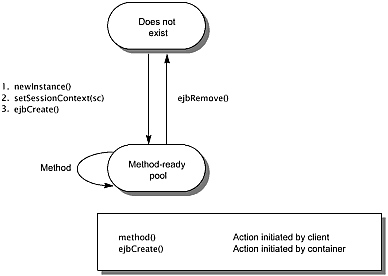EJB.6.8 Stateless Session Beans
| Stateless session beans are session beans whose instances have no conversational state. This means that all bean instances are equivalent when they are not involved in serving a client-invoked method. The term "stateless" signifies that an instance has no state for a specific client. However, the instance variables of the instance can contain the state across client-invoked method calls. Examples of such states include an open database connection and an object reference to an EJB object. The home interface of a stateless session bean must have one create method that takes no arguments and returns the session bean's remote interface. There can be no other create methods in the home interface. The session bean class must define a single ejbCreate method that takes no arguments. Because all instances of a stateless session bean are equivalent, the container can choose to delegate a client-invoked method to any available instance. This means, for example, that the container may delegate the requests from the same client within the same transaction to different instances, and that the container may interleave requests from multiple transactions to the same instance. A container only needs to retain the number of instances required to service the current client load. Due to client "think time," this number is typically much smaller than the number of active clients . Passivation is not needed for stateless sessions. The container creates another stateless session bean instance if one is needed to handle an increase in client work load. If a stateless session bean is not needed to handle the current client work load, the container can destroy it. Because stateless session beans minimize the resources needed to support a large population of clients, depending on the implementation of the container, applications that use stateless session beans may scale somewhat better than those using stateful session beans. However, this benefit may be offset by the increased complexity of the client application that uses the stateless beans. Clients use the create and remove methods on the home interface of a stateless session bean in the same way as on a stateful session bean. To the client, it appears as if the client controls the life cycle of the session object. However, the container handles the create and remove calls without necessarily creating and removing an EJB instance. There is no fixed mapping between clients and stateless instances. The container simply delegates a client's work to any available instance that is method-ready. A stateless session bean must not implement the javax.ejb.SessionSynchronization interface. EJB.6.8.1 Stateless Session Bean State DiagramWhen a client calls a method on a stateless session object, the container selects one of its method-ready instances and delegates the method invocation to it. Figure EJB.6-7 illustrates the life cycle of a stateless session bean instance. Figure EJB.6-7. Life Cycle of a Stateless Session Bean The following steps describe the life cyle of a session bean instance:
EJB.6.8.2 Operations Allowed in the Methods of a Stateless Session Bean ClassTable EJB.6-2 defines the methods of a stateless session bean class in which the session bean instances can access the methods of the javax.ejb.SessionContext interface, the java:comp/env environment naming context, resource managers, and other enterprise beans. If a session bean instance attempts to invoke a method of the SessionContext interface, and the access is not allowed in Table EJB.6-2, the container must throw the java.lang.IllegalStateException. If a session bean instance attempts to access a resource manager or an enterprise bean and the access is not allowed in Table EJB.6-2, the behavior is undefined by the EJB architecture. Table EJB.6-2. Operations Allowed in the Methods of a Stateless Session Bean
Additional restrictions:
The reasons for disallowing operations in Table EJB.6-2:
EJB.6.8.3 Dealing with ExceptionsA RuntimeException thrown from any method of the enterprise bean class (including the business methods and the callbacks invoked by the container) results in the transition to the "does not exist" state. Exception handling is described in detail in Chapter EJB.12. From the client perspective, the session object continues to exist. The client can continue accessing the session object because the container can delegate the client's requests to another instance. | |||||||||||||||||
EAN: 2147483647
Pages: 399
